Representation of Traffic Congestion Data for Urban Road Traffic Networks Based on Pooling Operations
Abstract
1. Introduction
- We develop an effective and cost-efficient representation framework for traffic congestion data of urban road networks. This framework combines grid-based partition of urban road traffic networks and a pooling function to reduce the size of traffic congestion data, while at the same time still retaining the spatial structure of road networks on a courser scale;
- We construct a model based on convolutional neural networks and long short-term memory neural networks to learn both spatiotemporal correlations and dependencies of traffic congestion between road segments and predict traffic congestion in road networks;
- The effectiveness and efficiency of our proposed representation framework is demonstrated by extensive experiments on a typical urban road traffic network.
2. The Proposed Approach
2.1. Grid-Based Partition of Congestion Data
2.2. Reduction of Grid Values
2.3. Prediction Model
3. Experiments
3.1. Dataset
3.2. Comparative Methods and Metric
3.3. Experiment Settings
3.4. Results
4. Conclusions
Author Contributions
Funding
Conflicts of Interest
References
- Zheng, Y.; Li, Y.; Own, C.M.; Meng, Z.; Gao, M. Real-Time Predication and Navigation on Traffic Congestion Model with Equilibrium Markov Chain. Int. J. Distrib. Sens. Netw. 2018, 14. [Google Scholar] [CrossRef]
- Wen, F.; Zhang, G.; Sun, L.; Wang, X.; Xu, X. A Hybrid Temporal Association Rules Mining Method for Traffic Congestion Prediction. Comput. Ind. Eng. 2019, 130, 779–787. [Google Scholar] [CrossRef]
- Liu, Y.; Wu, H. Prediction of Road Traffic Congestion Based on Random Forest. In Proceedings of the 2017 10th International Symposium on Computational Intelligence and Design (ISCID), Hangzhou, China, 9–10 December 2017; Volume 2, pp. 361–364. [Google Scholar] [CrossRef]
- Chen, M.; Yu, X.; Liu, Y. PCNN: Deep Convolutional Networks for Short-Term Traffic Congestion Prediction. IEEE Trans. Intell. Transp. Syst. 2018, 19, 3550–3559. [Google Scholar] [CrossRef]
- Yu, H.; Wu, Z.; Wang, S.; Wang, Y.; Ma, X. Spatiotemporal Recurrent Convolutional Networks for Traffic Prediction in Transportation Networks. Sensors 2017, 27, 1501. [Google Scholar] [CrossRef] [PubMed]
- Zhang, J.; Wang, F.Y.; Wang, K.; Lin, W.H.; Xu, X.; Chen, C. Data-Driven Intelligent Transportation Systems: A Survey. IEEE Trans. Intell. Transp. Syst. 2011, 12, 1624–1639. [Google Scholar] [CrossRef]
- Park, J.; Li, D.; Murphey, Y.L.; Kristinsson, J.; McGee, R.; Kuang, M.; Phillips, T. Real Time Vehicle Speed Prediction Using a Neural Network Traffic Model. In Proceedings of the 2011 International Joint Conference on Neural Networks, San Jose, CA, USA, 31 July–5 August 2011; pp. 2991–2996. [Google Scholar]
- Lieu, H.; Gartner, N.; Messer, C.; Rathi, A. Traffic flow theory. Public Roads 1999, 62, 45–47. [Google Scholar]
- Van Lint, J.W.C.; Van Hinsbergen, C. Short-Term Traffic and Travel Time Prediction Models. Artif. Intell. Appl. Crit. Transp. Issues 2012, 22, 22–41. [Google Scholar]
- Williams, B.M.; Hoel, L.A. Modeling and Forecasting Vehicular Traffic Flow as a Seasonal ARIMA Process: Theoretical Basis and Empirical Results. J. Transp. Eng. 2003, 129, 664–672. [Google Scholar] [CrossRef]
- Ghosh, B.; Basu, B.; O’Mahony, M. Time-Series Modelling for Forecasting Vehicular Traffic Flow in Dublin. In Proceedings of the 84th Annual Meeting of the Transportation Research Board, Washington, DC, USA, 9–13 January 2005. [Google Scholar]
- Tran, Q.T.; Ma, Z.; Li, H.; Hao, L.; Trinh, Q.K. A Multiplicative Seasonal ARIMA/GARCH Model in EVN Traffic Prediction. Int. J. Commun. Netw. Syst. Sci. 2015, 8, 43. [Google Scholar] [CrossRef]
- Van Der Voort, M.; Dougherty, M.; Watson, S. Combining Kohonen Maps with Arima Time Series Models to Forecast Traffic Flow. Transp. Res. Part C Emerg. Technol. 1996, 4, 307–318. [Google Scholar] [CrossRef]
- Williams, B. Multivariate Vehicular Traffic Flow Prediction: Evaluation of ARIMAX Modeling. Transp. Res. Rec. 2001, 1776, 194–200. [Google Scholar] [CrossRef]
- Szeto, W.Y.; Ghosh, B.; Basu, B.; O’Mahony, M. Multivariate Traffic Forecasting Technique Using Cell Transmission Model and SARIMA Model. J. Transp. Eng. 2009, 135, 658–667. [Google Scholar] [CrossRef]
- Alghamdi, T.; Elgazzar, K.; Bayoumi, M.; Sharaf, T.; Shah, S. Forecasting Traffic Congestion Using ARIMA Modeling. In Proceedings of the 2019 15th International Wireless Communications & Mobile Computing Conference (IWCMC), Tangier, Morocco, 24–28 June 2019; pp. 1227–1232. [Google Scholar]
- Cortes, C.; Vapnik, V. Support vector machine. Mach. Learn. 1995, 20, 273–297. [Google Scholar] [CrossRef]
- Wu, C.H.; Ho, J.M.; Lee, D.T. Travel-Time Prediction with Support Vector Regression. IEEE Trans. Intell. Transp. Syst. 2004, 5, 276–281. [Google Scholar] [CrossRef]
- Castro-Neto, M.; Jeong, Y.S.; Jeong, M.K.; Han, L.D. Online-SVR for Short-Term Traffic Flow Prediction under Typical and Atypical Traffic Conditions. Expert Syst. Appl. 2009, 36, 6164–6173. [Google Scholar] [CrossRef]
- Hong, W.C.; Dong, Y.; Zheng, F.; Lai, C.Y. Forecasting Urban Traffic Flow by SVR with Continuous ACO. Appl. Math. Model. 2011, 35, 1282–1291. [Google Scholar] [CrossRef]
- Yue-sheng, G.; Ding, W.; Ming-fu, Z. A New Intelligent Model for Short Time Traffic Flow Prediction via EMD and PSO–SVM. In Green Communications and Networks; Springer: Berlin, Germany, 2012; pp. 59–66. [Google Scholar]
- Liu, Y.; Zheng, H.; Feng, X.; Chen, Z. Short-Term Traffic Flow Prediction with Conv-LSTM. In Proceedings of the 2017 9th International Conference on Wireless Communications and Signal Processing (WCSP), Nanjing, China, 11–13 October 2017; pp. 1–6. [Google Scholar] [CrossRef]
- Huang, W.; Song, G.; Hong, H.; Xie, K. Deep Architecture for Traffic Flow Prediction: Deep Belief Networks With Multitask Learning. IEEE Trans. Intell. Transp. Syst. 2014, 15, 2191–2201. [Google Scholar] [CrossRef]
- Qu, L.; Li, W.; Li, W.; Ma, D.; Wang, Y. Daily Long-Term Traffic Flow Forecasting Based on a Deep Neural Network. Expert Syst. Appl. 2019, 121, 304–312. [Google Scholar] [CrossRef]
- Sharma, S.; Mehra, R. Implications of Pooling Strategies in Convolutional Neural Networks: A Deep Insight. Found. Comput. Decis. Sci. 2019, 44, 303–330. [Google Scholar] [CrossRef]
- Hu, Y.; Li, M.; Liu, H.; Guo, X.; Wang, X.; Li, T. City Traffic Forecasting Using Taxi GPS Data: A Coarse-Grained Cellular Automata Model. arXiv 2016, arXiv:1612.02540. [Google Scholar]
- Zhang, J.; Zheng, Y.; Qi, D. Deep Spatio-Temporal Residual Networks for Citywide Crowd Flows Prediction. In Proceedings of the Thirty-First AAAI Conference on Artificial Intelligence, San Francisco, CA, USA, 4–9 February 2017; pp. 1655–1661. [Google Scholar]
- Xu, J.; Zhang, Y.; Jia, Y.; Xing, C. An Efficient Traffic Prediction Model Using Deep Spatial-Temporal Network. In Proceedings of the International Conference on Collaborative Computing: Networking, Applications and Worksharing, Shanghai, China, 1–3 December 2018; Springer: Berlin, Germany, 2018; pp. 386–399. [Google Scholar]
- Duan, Z.; Zhang, K.; Chen, Z.; Liu, Z.; Tang, L.; Yang, Y.; Ni, Y. Prediction of City-Scale Dynamic Taxi Origin-Destination Flows Using a Hybrid Deep Neural Network Combined With Travel Time. IEEE Access 2019, 7, 127816–127832. [Google Scholar] [CrossRef]
- Zhang, S.; Yao, Y.; Hu, J.; Zhao, Y.; Li, S.; Hu, J. Deep Autoencoder Neural Networks for Short-Term Traffic Congestion Prediction of Transportation Networks. Sensors 2019, 19, 2229. [Google Scholar] [CrossRef] [PubMed]
- Youssef, A. Image Downsampling and Upsampling Methods; National Institute of Standards and Technology: Gaithersburg, MD, USA, 1999.
- Sisiopiku, V.P.; Rostami-Hosuri, S. Congestion Quantification Using the National Performance Management Research Data Set. Data 2017, 2, 39. [Google Scholar] [CrossRef]
- Nair, D.J.; Gilles, F.; Chand, S.; Saxena, N.; Dixit, V. Characterizing Multicity Urban Traffic Conditions Using Crowdsourced Data. PLoS ONE 2019, 14, e0212845. [Google Scholar] [CrossRef]
- Ioffe, S.; Szegedy, C. Batch Normalization: Accelerating Deep Network Training by Reducing Internal Covariate Shift. arXiv 2015, arXiv:1502.03167. [Google Scholar]
- Mahmood, A.; Bennamoun, M.; An, S.; Sohel, F.; Boussaid, F.; Hovey, R.; Kendrick, G.; Fisher, R.B. Deep learning for coral classification. In Handbook of Neural Computation; Elsevier: Amsterdam, The Netherlands, 2017; pp. 383–401. [Google Scholar]
- Yao, H.; Wu, F.; Ke, J.; Tang, X.; Jia, Y.; Lu, S.; Gong, P.; Ye, J.; Li, Z. Deep multi-view spatial-temporal network for taxi demand prediction. In Proceedings of the Thirty-Second AAAI Conference on Artificial Intelligence, New Orleans, LA, USA, 2–7 February 2018. [Google Scholar]
- Zhang, W.; Yu, Y.; Qi, Y.; Shu, F.; Wang, Y. Short-term traffic flow prediction based on spatio-temporal analysis and CNN deep learning. Transp. A Transp. Sci. 2019, 15, 1688–1711. [Google Scholar] [CrossRef]
- Hochreiter, S.; Schmidhuber, J. Long Short-Term Memory. Neural Comput. 1997, 9, 1735–1780. [Google Scholar] [CrossRef]
- Zhao, Z.; Chen, W.; Wu, X.; Chen, P.C.; Liu, J. LSTM Network: A Deep Learning Approach for Short-Term Traffic Forecast. IET Intell. Transp. Syst. 2017, 11, 68–75. [Google Scholar] [CrossRef]
- Nguyen, H.; Kieu, L.M.; Wen, T.; Cai, C. Deep Learning Methods in Transportation Domain: A Review. IET Intell. Transp. Syst. 2018, 12, 998–1004. [Google Scholar] [CrossRef]
- Wang, J.; Chen, R.; He, Z. Traffic Speed Prediction for Urban Transportation Network: A Path Based Deep Learning Approach. Transp. Res. Part C Emerg. Technol. 2019, 100, 372–385. [Google Scholar] [CrossRef]
- Wu, Y.; Tan, H. Short-Term Traffic Flow Forecasting with Spatial-Temporal Correlation in a Hybrid Deep Learning Framework. arXiv 2016, arXiv:1612.01022. [Google Scholar]
- Duan, Z.; Yang, Y.; Zhang, K.; Ni, Y.; Bajgain, S. Improved Deep Hybrid Networks for Urban Traffic Flow Prediction Using Trajectory Data. IEEE Access 2018, 6, 31820–31827. [Google Scholar] [CrossRef]
- Shi, Y.; Feng, H.; Geng, X.; Tang, X.; Wang, Y. A Survey of Hybrid Deep Learning Methods for Traffic Flow Prediction. In Proceedings of the 2019 3rd International Conference on Advances in Image Processing (ICAIP), Chengdu, China, 8–10 November 2019; pp. 133–138. [Google Scholar] [CrossRef]
- Bodvarsson, G.A.; Muench, S.T. Effects of Loop Detector Installation on the Portland Cement Concrete Pavement Lifespan: Case Study on I-5; Technical Report; Department of Transportation, Office of Research and Library: Washington, DC, USA, 2010.
- Google Maps. Available online: https://www.google.com/maps (accessed on 6 October 2018).
- WSDOT—Traffic Map Archive. Available online: https://www.wsdot.wa.gov/data/tools/traffic/maps/archive/ (accessed on 21 December 2019).
- Houston TranStar—Speed Map Archive. Available online: http://traffic.houstontranstar.org/map_archive/ (accessed on 21 December 2019).
- Traffic Analysis Report Of China’s Major Cities. Available online: https://report.amap.com/ (accessed on 21 December 2019).
- AutoNavi Map. Available online: https://ditu.amap.com (accessed on 6 March 2018).
- Parker, J.A.; Kenyon, R.V.; Troxel, D.E. Comparison of Interpolating Methods for Image Resampling. IEEE Trans. Med. Imaging 1983, 2, 31–39. [Google Scholar] [CrossRef] [PubMed]
- Liu, W.; Sun, Y.; Ji, Q. MDAN-UNet: Multi-Scale and Dual Attention Enhanced Nested U-Net Architecture for Segmentation of Optical Coherence Tomography Images. Algorithms 2020, 13, 60. [Google Scholar] [CrossRef]
- Brownrigg, D.R. The Weighted Median Filter. Commun. ACM 1984. [Google Scholar] [CrossRef]
- Ko, S.J.; Lee, Y. Center Weighted Median Filters and Their Applications to Image Enhancement. IEEE Trans. Circuits Syst. 1991, 38, 984–993. [Google Scholar] [CrossRef]
- Chollet, F. Keras. 2015. Available online: https://github.com/fchollet/keras (accessed on 22 June 2018).
- Tieleman, T.; Hinton, G. Lecture 6.5-Rmsprop: Divide the Gradient by a Running Average of Its Recent Magnitude. COURSERA Neural Netw. Mach. Learn. 2012, 4, 26–31. [Google Scholar]
- Koesdwiady, A.; Soua, R.; Karray, F. Improving Traffic Flow Prediction with Weather Information in Connected Cars: A Deep Learning Approach. IEEE Trans. Veh. Technol. 2016, 65, 9508–9517. [Google Scholar] [CrossRef]
- Masci, J.; Meier, U.; Cireşan, D.; Schmidhuber, J. Stacked Convolutional Auto-Encoders for Hierarchical Feature Extraction. In Proceedings of the International Conference on Artificial Neural Networks, Espoo, Finland, 14–17 June 2011; Springer: Berlin, Germany, 2011; pp. 52–59. [Google Scholar]
- Giusti, A.; Cireşan, D.C.; Masci, J.; Gambardella, L.M.; Schmidhuber, J. Fast Image Scanning with Deep Max-Pooling Convolutional Neural Networks. In Proceedings of the 2013 IEEE International Conference on Image Processing, Melbourne, Australia, 15–18 September 2013; pp. 4034–4038. [Google Scholar]
- Ronneberger, O.; Fischer, P.; Brox, T. U-Net: Convolutional Networks for Biomedical Image Segmentation. In Medical Image Computing and Computer-Assisted Intervention—MICCAI 2015; Navab, N., Hornegger, J., Wells, W.M., Frangi, A.F., Eds.; Lecture Notes in Computer Science; Springer: Cham, Switzerland, 2015; pp. 234–241. [Google Scholar] [CrossRef]
- Subramaniam, A.; Chatterjee, M.; Mittal, A. Deep neural networks with inexact matching for person re-identification. In Proceedings of the 30th Conference on Neural Information Processing Systems (NIPS 2016), Barcelona, Spain, 9 December 2016; pp. 2667–2675. [Google Scholar]
- Boulch, A.; Le Saux, B.; Audebert, N. Unstructured Point Cloud Semantic Labeling Using Deep Segmentation Networks. 3DOR 2017, 2, 7. [Google Scholar]
- Abadi, M.; Barham, P.; Chen, J.; Chen, Z.; Davis, A.; Dean, J.; Devin, M.; Ghemawat, S.; Irving, G.; Isard, M.; et al. TensorFlow: A system for large-scale machine learning. In Proceedings of the 12th USENIX Symposium on Operating Systems Design and Implementation (OSDI 16), Savannah, GA, USA, 2–4 November 2016; pp. 265–283. [Google Scholar]
- Zhang, Y.; Zhao, D.; Zhang, J.; Xiong, R.; Gao, W. Interpolation-dependent image downsampling. IEEE Trans. Image Process. 2011, 20, 3291–3296. [Google Scholar] [CrossRef]
- Díaz García, J.; Brunet Crosa, P.; Navazo Álvaro, I.; Vázquez Alcocer, P.P. Downsampling methods for medical datasets. In Proceedings of the International Conferences Computer Graphics, Visualization, Computer Vision and Image Processing 2017 and Big Data Analytics, Data Mining and Computational Intelligence 2017, Lisbon, Portugal, 21–23 July 2017; pp. 12–20. [Google Scholar]
- Sergeev, A.; Del Balso, M. Horovod: Fast and easy distributed deep learning in TensorFlow. arXiv 2018, arXiv:1802.05799. [Google Scholar]
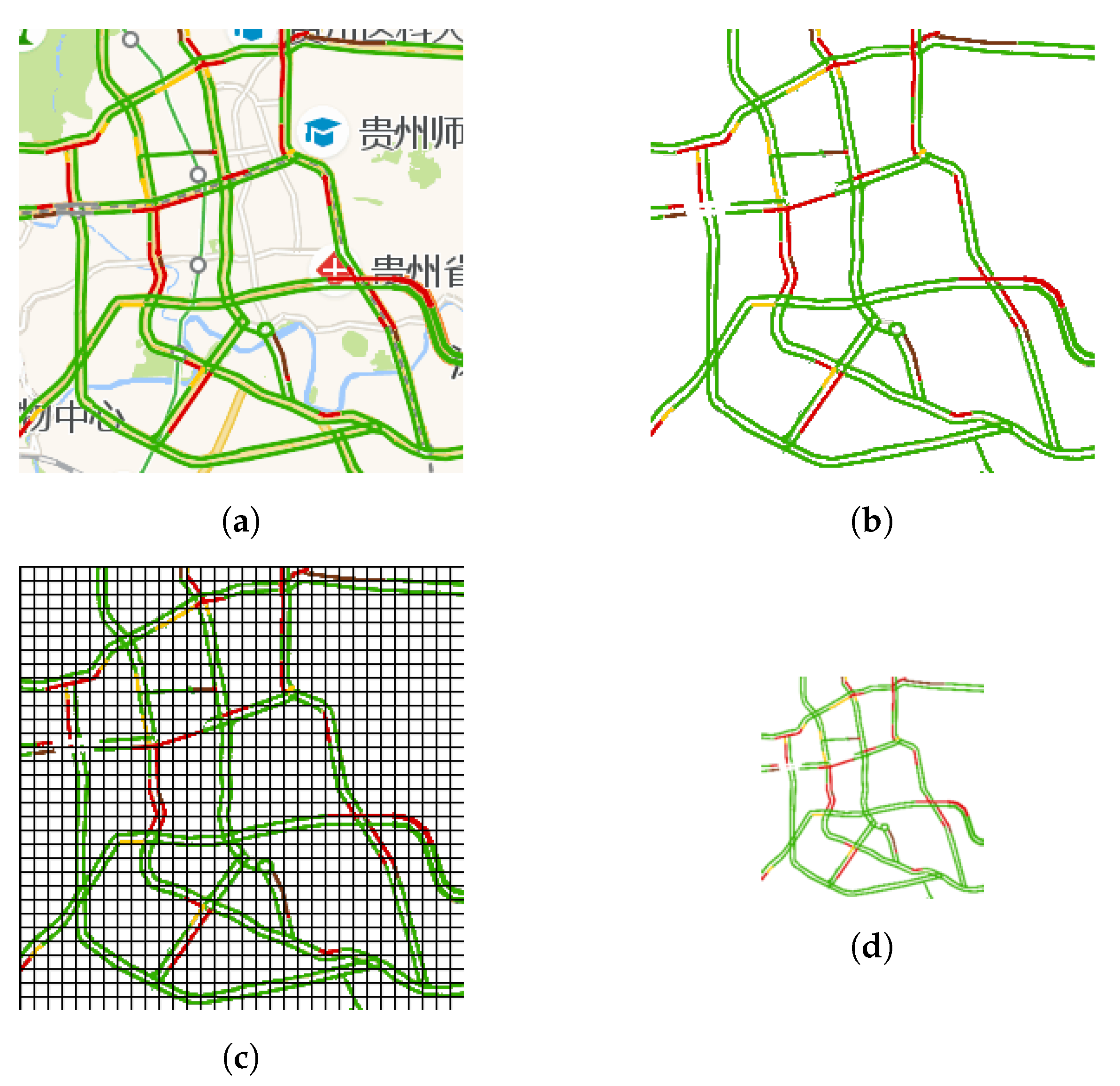
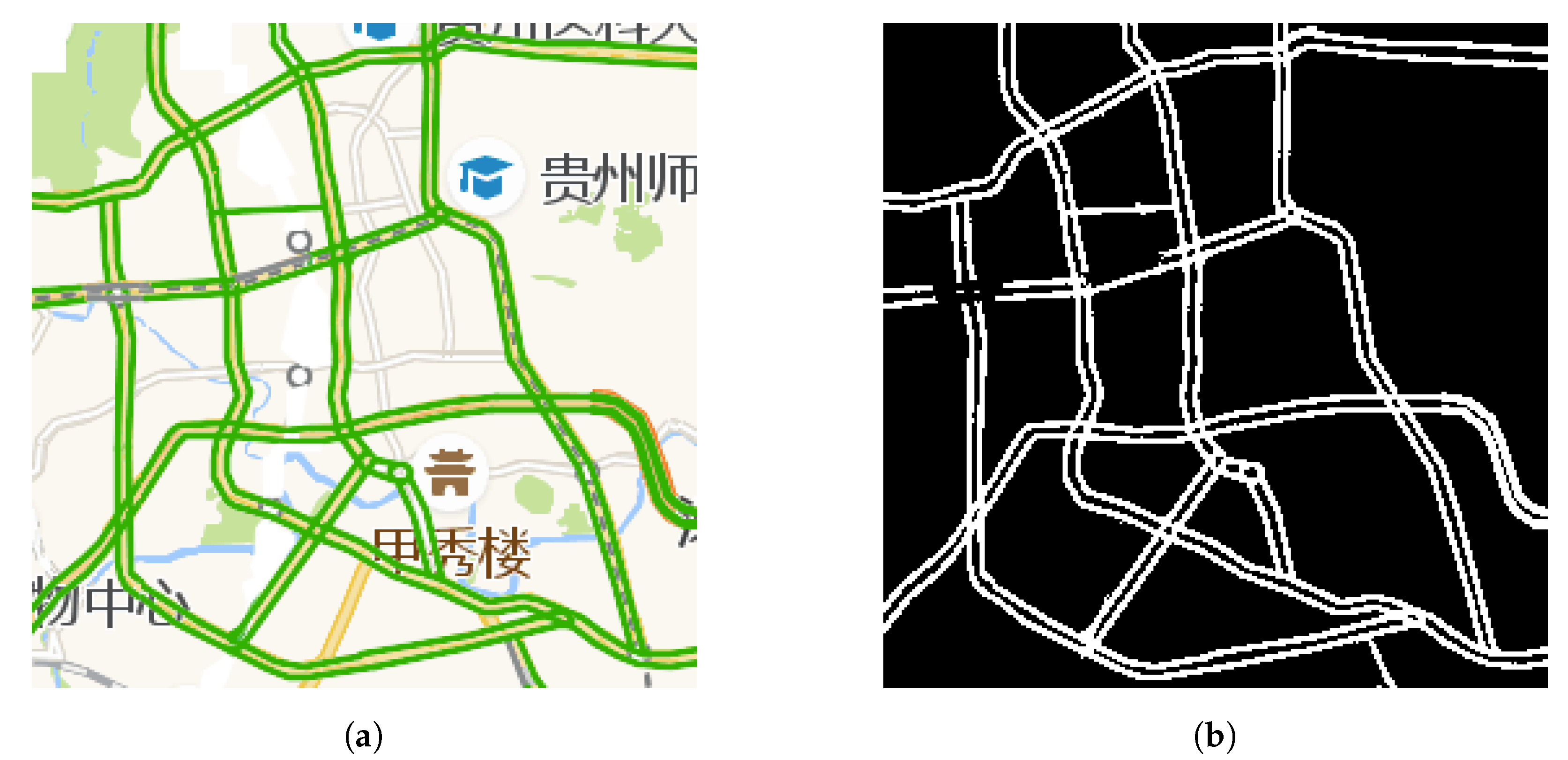
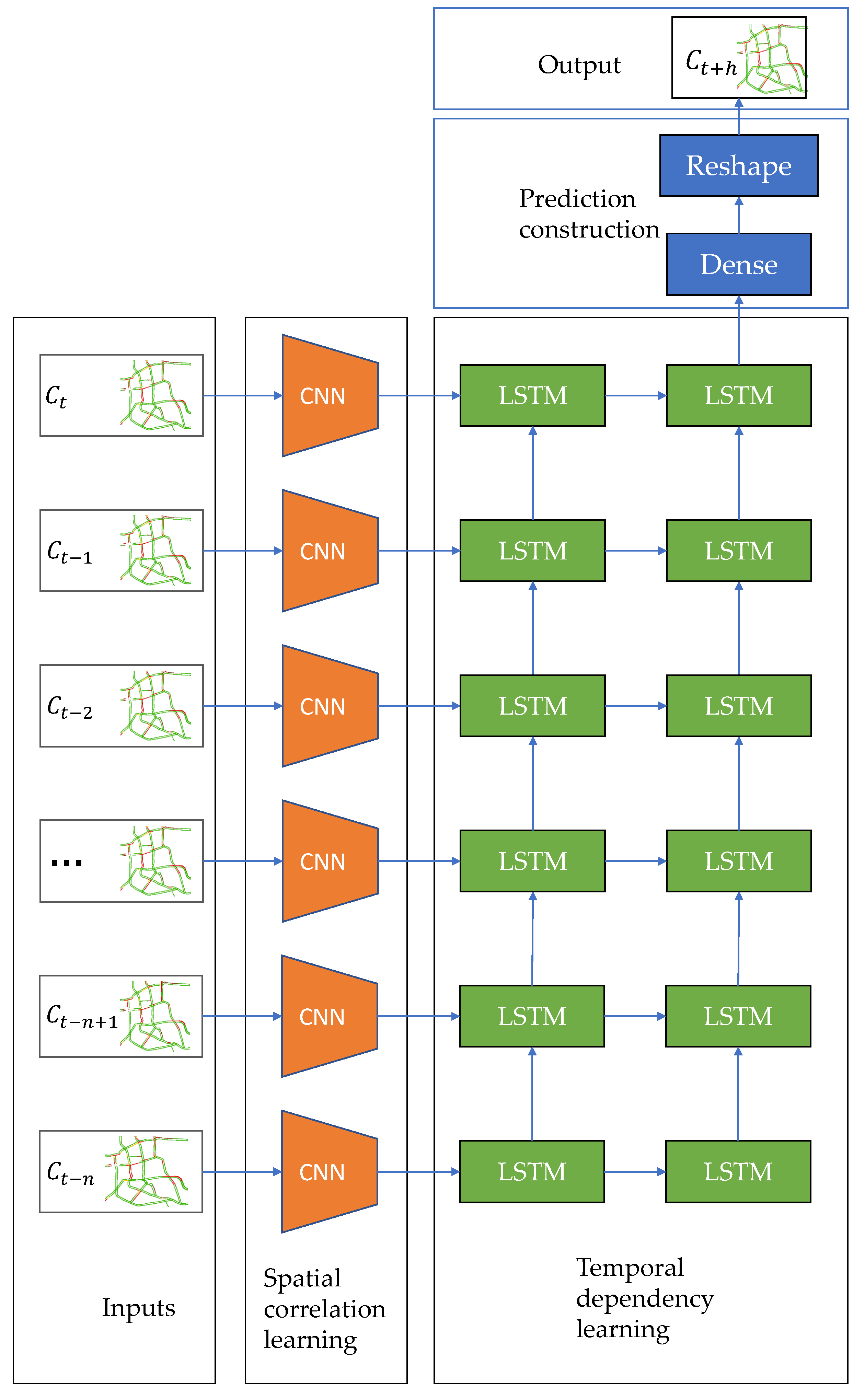
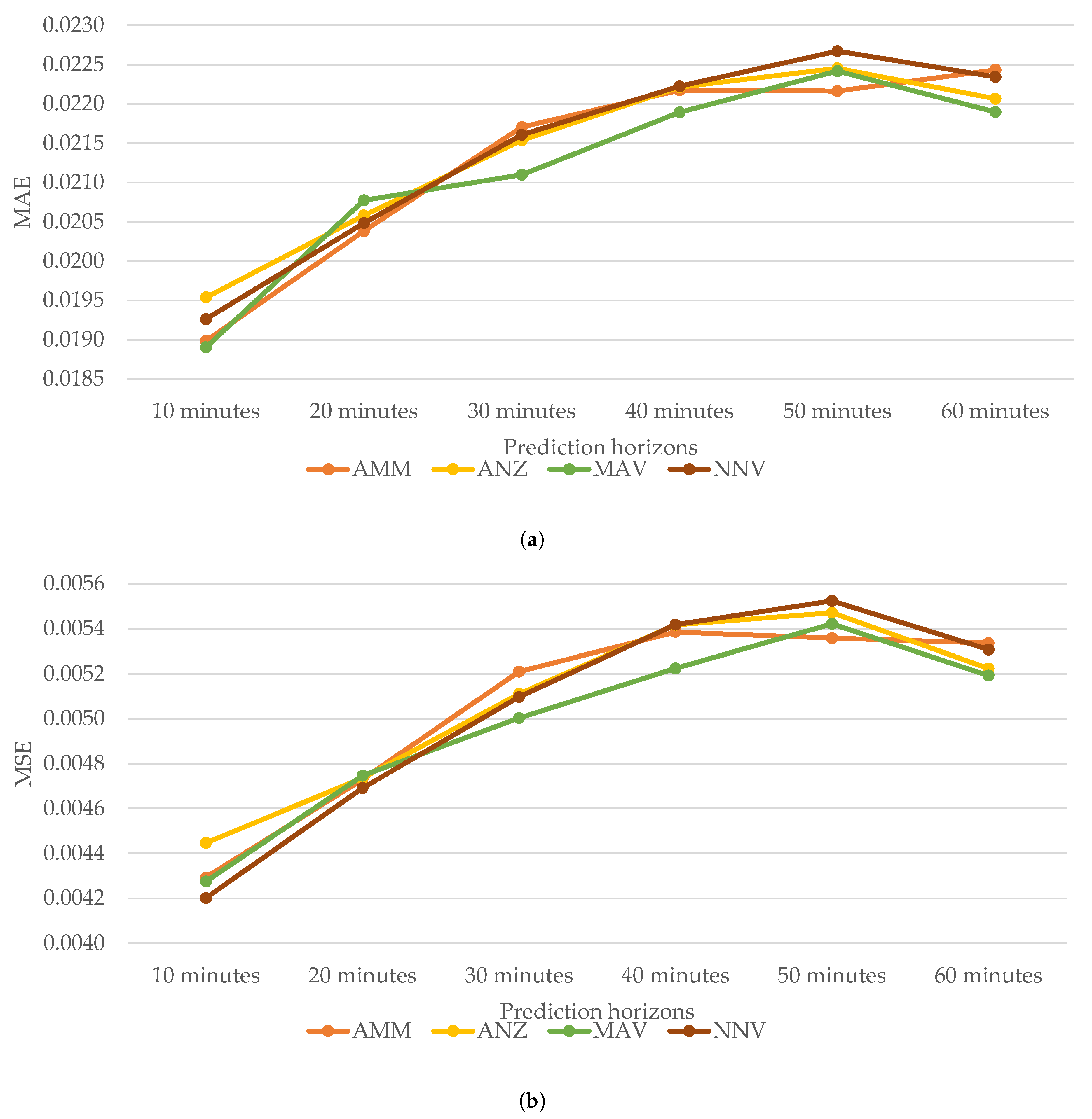
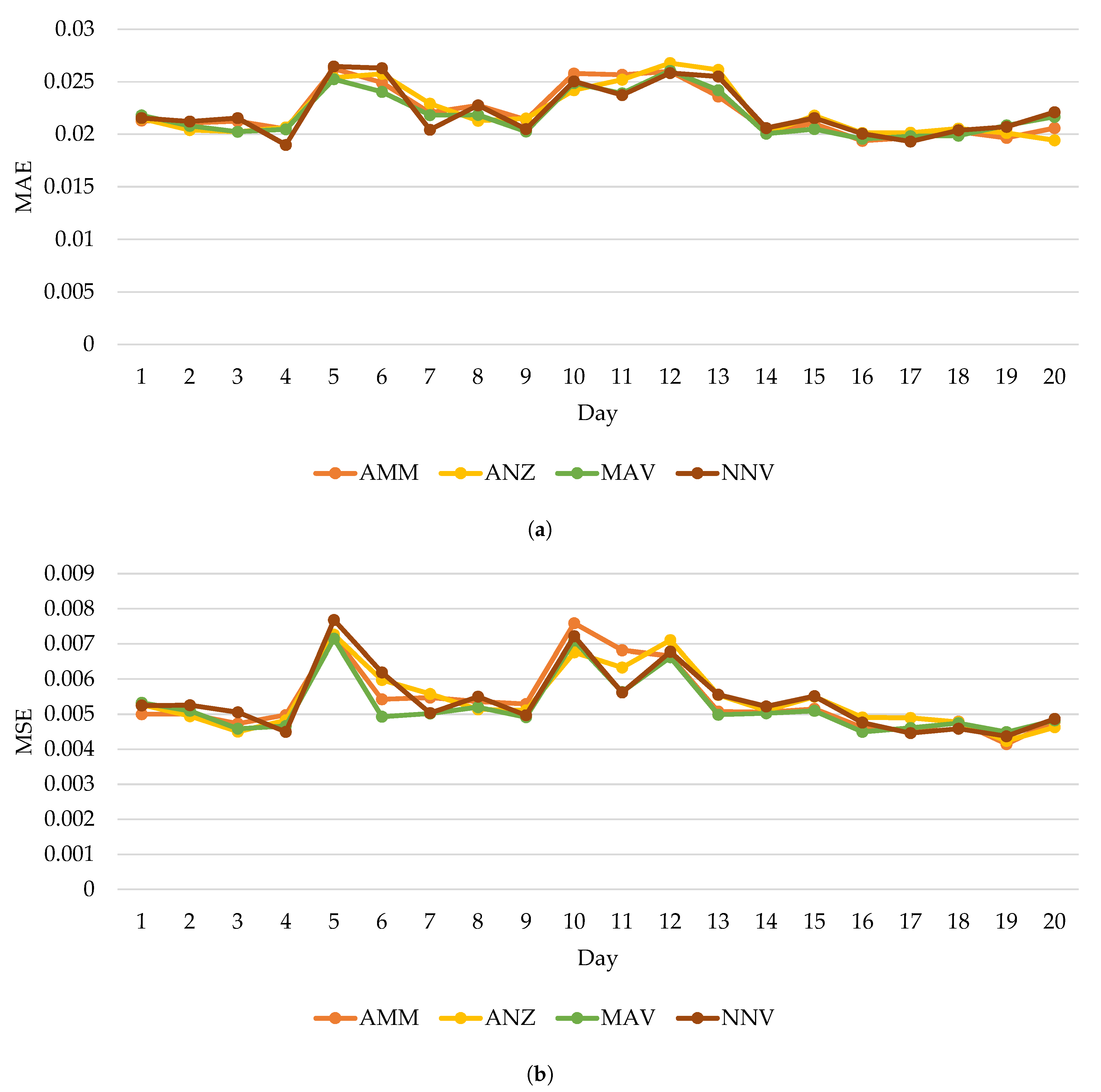
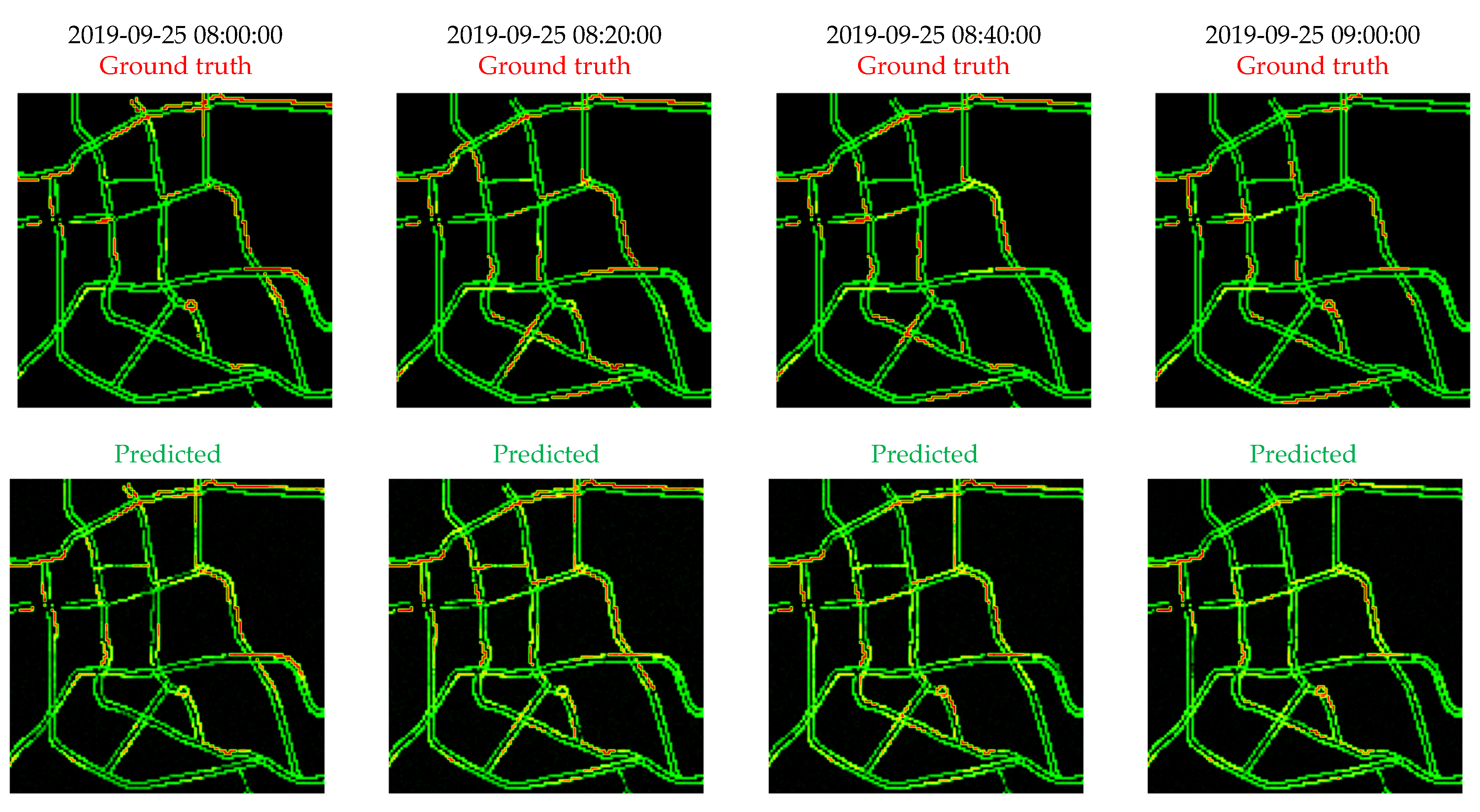
| Layer | Name | Channels | Size |
|---|---|---|---|
| 1 | Inputs | 1 | (128, 128) |
| 2 | Convolution | 64 | (3, 3) |
| Max-Pooling | 64 | (2, 2) | |
| Activation (Relu) | - | - | |
| Batch-Normalization | - | - | |
| 3 | Convolution | 32 | (3, 3) |
| Max-Pooling | 32 | (2, 2) | |
| Activation (Relu) | - | - | |
| Batch-Normalization | - | - | |
| 4 | Convolution | 16 | (3, 3) |
| Max-Pooling | 16 | (2, 2) | |
| Activation (Relu) | - | - | |
| Batch-Normalization | - | - | |
| 5 | Convolution | 8 | (3, 3) |
| Max-Pooling | 8 | (2, 2) | |
| Activation (Relu) | - | - | |
| Batch-Normalization | - | - | |
| 6 | Flatten | - | - |
| 7 | LSTM1 | - | (12, 800) |
| Activation (tanh) | - | - | |
| 8 | LSTM2 | - | 800 |
| Activation (tanh) | - | - | |
| 9 | Dropout(0.1) | - | - |
| 10 | Fully Connected | - | 16,384 |
| 11 | Output | 1 | (128, 128) |
| 10 min | 20 min | |||||||
|---|---|---|---|---|---|---|---|---|
| AMM | ANZ | MAV | NNV | AMM | ANZ | MAV | NNV | |
| Averaged daily metrics | ||||||||
| MSE | 0.0043 | 0.0044 | 0.0043 | 0.0042 | 0.0047 | 0.0047 | 0.0047 | 0.0047 |
| MAE | 0.0190 | 0.0195 | 0.0189 | 0.0193 | 0.0204 | 0.0206 | 0.0208 | 0.0205 |
| roMAPE | 5.0817 | 4.9862 | 5.0566 | 5.0022 | 5.3700 | 5.5199 | 5.5353 | 5.6462 |
| 30 min | 40 min | |||||||
| AMM | ANZ | MAV | NNV | AMM | ANZ | MAV | NNV | |
| Averaged daily metrics | ||||||||
| MSE | 0.0052 | 0.0051 | 0.0050 | 0.0051 | 0.0054 | 0.0054 | 0.0052 | 0.0054 |
| MAE | 0.0217 | 0.0215 | 0.0211 | 0.0216 | 0.0222 | 0.0222 | 0.0219 | 0.0222 |
| roMAPE | 5.7817 | 5.8474 | 5.6986 | 5.8093 | 6.0554 | 5.9054 | 5.8901 | 5.9548 |
| 50 min | 60 min | |||||||
| AMM | ANZ | MAV | NNV | AMM | ANZ | MAV | NNV | |
| Averaged daily metrics | ||||||||
| MSE | 0.0054 | 0.0055 | 0.0054 | 0.0055 | 0.0053 | 0.0052 | 0.0052 | 0.0053 |
| MAE | 0.0222 | 0.0225 | 0.0224 | 0.0227 | 0.0224 | 0.0221 | 0.0219 | 0.0223 |
| roMAEP | 5.8380 | 5.9921 | 5.8229 | 5.8546 | 5.8230 | 5.7164 | 5.7862 | 5.9178 |
| AMM | ANZ | MAV | NNV | |
|---|---|---|---|---|
| Standard variation of MAE | ||||
| Standard variation of MSE |
| Original Matrices (Using Horovod) | Down-Sampled Using MAV | |
|---|---|---|
| Average training time per epoch (seconds) | 17 | |
| GPU memory usage (megabytes) | 10,613 |
| 10 min | 20 min | 30 min | ||||
|---|---|---|---|---|---|---|
| MAV | ORIGINAL | MAV | ORIGINAL | MAV | ORIGINAL | |
| Averaged metrics | ||||||
| MSE | 0.0044 | 0.0041 | 0.0047 | 0.0048 | 0.0050 | 0.0053 |
| MAE | 0.0191 | 0.0190 | 0.0208 | 0.0209 | 0.0211 | 0.0220 |
| 40 min | 50 min | 60 in | ||||
| MAV | ORIGINAL | MAV | ORIGINAL | MAV | ORIGINAL | |
| Averaged metrics | ||||||
| MSE | 0.0052 | 0.0051 | 0.0054 | 0.0054 | 0.0052 | 0.0054 |
| MAE | 0.0219 | 0.0217 | 0.0224 | 0.0224 | 0.0219 | 0.0226 |
© 2020 by the authors. Licensee MDPI, Basel, Switzerland. This article is an open access article distributed under the terms and conditions of the Creative Commons Attribution (CC BY) license (http://creativecommons.org/licenses/by/4.0/).
Share and Cite
Zhang, S.; Li, S.; Li, X.; Yao, Y. Representation of Traffic Congestion Data for Urban Road Traffic Networks Based on Pooling Operations. Algorithms 2020, 13, 84. https://doi.org/10.3390/a13040084
Zhang S, Li S, Li X, Yao Y. Representation of Traffic Congestion Data for Urban Road Traffic Networks Based on Pooling Operations. Algorithms. 2020; 13(4):84. https://doi.org/10.3390/a13040084
Chicago/Turabian StyleZhang, Sen, Shaobo Li, Xiang Li, and Yong Yao. 2020. "Representation of Traffic Congestion Data for Urban Road Traffic Networks Based on Pooling Operations" Algorithms 13, no. 4: 84. https://doi.org/10.3390/a13040084
APA StyleZhang, S., Li, S., Li, X., & Yao, Y. (2020). Representation of Traffic Congestion Data for Urban Road Traffic Networks Based on Pooling Operations. Algorithms, 13(4), 84. https://doi.org/10.3390/a13040084





